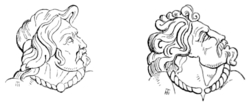Marcomanni, as proposed by Blackie[1].
The barbarians have two kinds of torques, one on a prostrate figure at the side of the sarcophagus is funicular and bulbous, the other upon a prisoner at the corner terminates in a bulbous clasp. The Dacians did not wear them, and the statue called the dying gladiator, which also has this decoration, may be referred to the same period[2]. Under Commodus it is mentioned as the ornament of gladiators, probably because these men were universally Germans and Gauls[3]. Herodian under Gordianus Pius A.D. 247, alludes to the iron torques round the neck and loins of the British Celts[4]. A succession of authors down to the eleventh century continue to mention it, but, as it had been adopted by the Romans, probably in relation to them only[5]. A considerable change however took place in its application as the Romans came in contact with the Celtic population, and were forced by their political necessities to incorporate the hardy barbarians in their service. It gradually became with them a military order, bestowed upon the field of battle, especially after engagements with the Celtic or German races. The first mention of such an employment of it is by Julius Cæsar, who bestowed a pair of golden torques on the præfect of the Cassian horse[6]. Augustus continued the custom[7], and an inscription records a donation of this emperor[8].
Although few instances occur on monuments at Rome, of Romans wearing this decoration, it is not improbable that the provincial officers wore it in their local jurisdictions. M. Cœlius the officer who was killed in the fight with Arminius, and whose monument exists at Dusseldorf[9], wears a funicular torques round the neck. This was under Augustus; and Flavius reproaches Arminius himself with receiving a torques[10] from the Romans.
- ↑ Blackie, John, in the Annali del Instit. Archæol. di Roma. III. p. 287. sq.
- ↑ Osservazioni artistici antiquarii sopra la statua volgarmente appellata il gladiatore moribondo del Prof. A. Nibbi estratto dell. Ephemeridi litterarie di Roma. Aprili 1831, pegg. 51.
- ↑ Capitol. vita Com.
- ↑ xxxiii. c. 2.
- ↑ Cf. Scheffer. p. 55. sq.
- ↑ Hirtius, Bell. Hisp. vi. 26.
- ↑ Sueton., vita Aug. c. xxv.—xliii. Quint. vi. c. 4.
- ↑ Gruter, Corp. Insc., p. xcii.
- ↑ Wagener, Handbuch der vorzüglichsten in Deutschland entdeckten Alterthümer. 8vo. Weimar, 1842. pl. 138. 1323.
- ↑ Tacit. Ann. ii. c. 29.

